Comprehensive Analysis of Brand Management for Frasers Group
VerifiedAdded on 2023/01/05
|19
|6895
|98
Report
AI Summary
This report provides a comprehensive analysis of brand management, using Frasers Group as a case study. It begins by explaining the importance of branding as a marketing tool, highlighting its evolution and significance within the company. The report then delves into key components of successful brand strategy, including brand loyalty, awareness, and association, and analyzes how these elements contribute to building and managing brand equity. It further examines distinct strategies related to portfolio management, brand equity management, and brand hierarchy management, critically evaluating these aspects using appropriate frameworks and models. The report also evaluates how brands are managed collectively and in partnership at both domestic and global levels, along with a critical evaluation of different techniques to measure and manage brand value, concluding with a detailed discussion on the application of these techniques for developing a strong and enduring brand. The report offers insights into how Frasers Group can strengthen its brand in a competitive market.

Brand Management
1
1
Paraphrase This Document
Need a fresh take? Get an instant paraphrase of this document with our AI Paraphraser
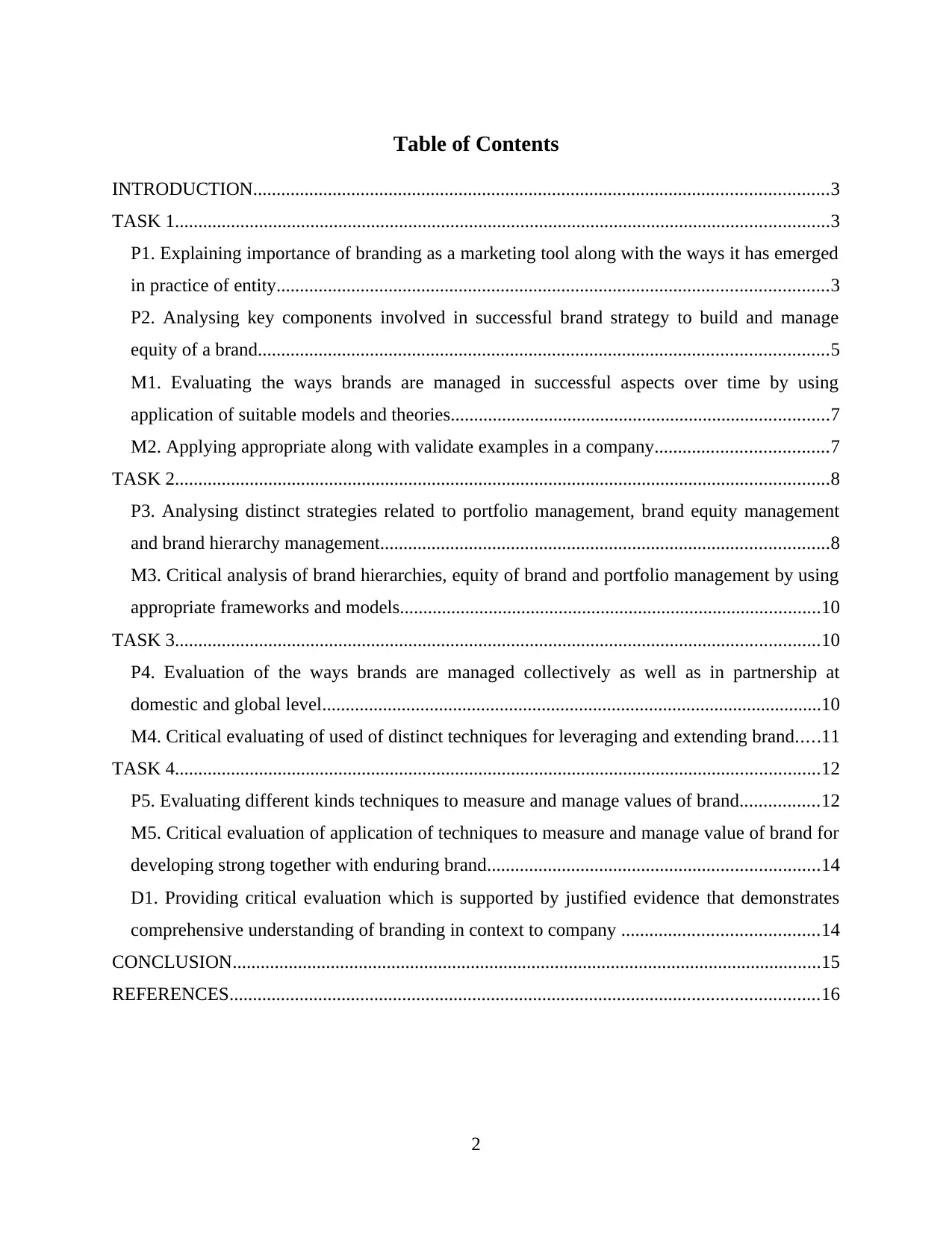
Table of Contents
INTRODUCTION...........................................................................................................................3
TASK 1............................................................................................................................................3
P1. Explaining importance of branding as a marketing tool along with the ways it has emerged
in practice of entity......................................................................................................................3
P2. Analysing key components involved in successful brand strategy to build and manage
equity of a brand..........................................................................................................................5
M1. Evaluating the ways brands are managed in successful aspects over time by using
application of suitable models and theories.................................................................................7
M2. Applying appropriate along with validate examples in a company.....................................7
TASK 2............................................................................................................................................8
P3. Analysing distinct strategies related to portfolio management, brand equity management
and brand hierarchy management................................................................................................8
M3. Critical analysis of brand hierarchies, equity of brand and portfolio management by using
appropriate frameworks and models..........................................................................................10
TASK 3..........................................................................................................................................10
P4. Evaluation of the ways brands are managed collectively as well as in partnership at
domestic and global level...........................................................................................................10
M4. Critical evaluating of used of distinct techniques for leveraging and extending brand.....11
TASK 4..........................................................................................................................................12
P5. Evaluating different kinds techniques to measure and manage values of brand.................12
M5. Critical evaluation of application of techniques to measure and manage value of brand for
developing strong together with enduring brand.......................................................................14
D1. Providing critical evaluation which is supported by justified evidence that demonstrates
comprehensive understanding of branding in context to company ..........................................14
CONCLUSION..............................................................................................................................15
REFERENCES..............................................................................................................................16
2
INTRODUCTION...........................................................................................................................3
TASK 1............................................................................................................................................3
P1. Explaining importance of branding as a marketing tool along with the ways it has emerged
in practice of entity......................................................................................................................3
P2. Analysing key components involved in successful brand strategy to build and manage
equity of a brand..........................................................................................................................5
M1. Evaluating the ways brands are managed in successful aspects over time by using
application of suitable models and theories.................................................................................7
M2. Applying appropriate along with validate examples in a company.....................................7
TASK 2............................................................................................................................................8
P3. Analysing distinct strategies related to portfolio management, brand equity management
and brand hierarchy management................................................................................................8
M3. Critical analysis of brand hierarchies, equity of brand and portfolio management by using
appropriate frameworks and models..........................................................................................10
TASK 3..........................................................................................................................................10
P4. Evaluation of the ways brands are managed collectively as well as in partnership at
domestic and global level...........................................................................................................10
M4. Critical evaluating of used of distinct techniques for leveraging and extending brand.....11
TASK 4..........................................................................................................................................12
P5. Evaluating different kinds techniques to measure and manage values of brand.................12
M5. Critical evaluation of application of techniques to measure and manage value of brand for
developing strong together with enduring brand.......................................................................14
D1. Providing critical evaluation which is supported by justified evidence that demonstrates
comprehensive understanding of branding in context to company ..........................................14
CONCLUSION..............................................................................................................................15
REFERENCES..............................................................................................................................16
2
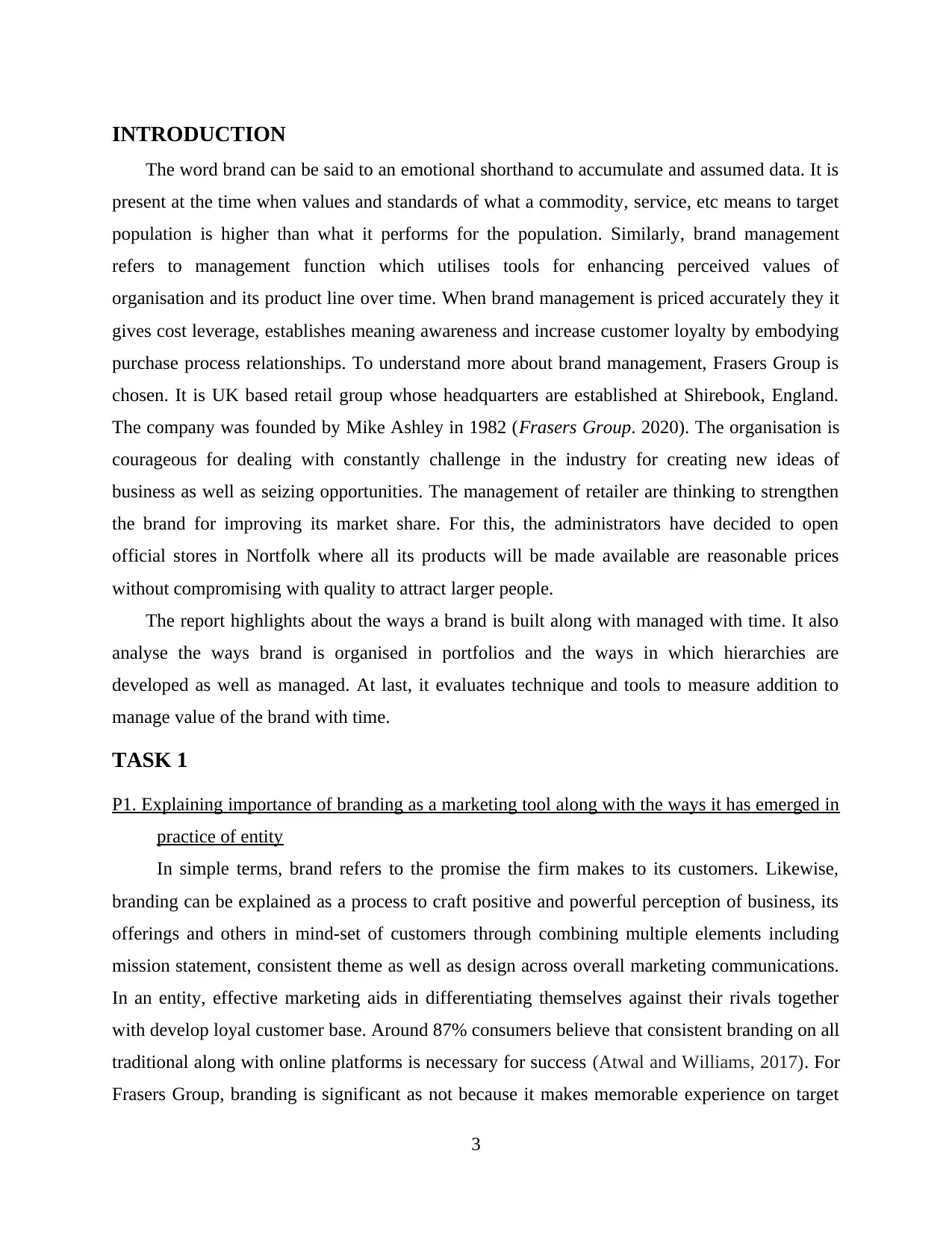
INTRODUCTION
The word brand can be said to an emotional shorthand to accumulate and assumed data. It is
present at the time when values and standards of what a commodity, service, etc means to target
population is higher than what it performs for the population. Similarly, brand management
refers to management function which utilises tools for enhancing perceived values of
organisation and its product line over time. When brand management is priced accurately they it
gives cost leverage, establishes meaning awareness and increase customer loyalty by embodying
purchase process relationships. To understand more about brand management, Frasers Group is
chosen. It is UK based retail group whose headquarters are established at Shirebook, England.
The company was founded by Mike Ashley in 1982 (Frasers Group. 2020). The organisation is
courageous for dealing with constantly challenge in the industry for creating new ideas of
business as well as seizing opportunities. The management of retailer are thinking to strengthen
the brand for improving its market share. For this, the administrators have decided to open
official stores in Nortfolk where all its products will be made available are reasonable prices
without compromising with quality to attract larger people.
The report highlights about the ways a brand is built along with managed with time. It also
analyse the ways brand is organised in portfolios and the ways in which hierarchies are
developed as well as managed. At last, it evaluates technique and tools to measure addition to
manage value of the brand with time.
TASK 1
P1. Explaining importance of branding as a marketing tool along with the ways it has emerged in
practice of entity
In simple terms, brand refers to the promise the firm makes to its customers. Likewise,
branding can be explained as a process to craft positive and powerful perception of business, its
offerings and others in mind-set of customers through combining multiple elements including
mission statement, consistent theme as well as design across overall marketing communications.
In an entity, effective marketing aids in differentiating themselves against their rivals together
with develop loyal customer base. Around 87% consumers believe that consistent branding on all
traditional along with online platforms is necessary for success (Atwal and Williams, 2017). For
Frasers Group, branding is significant as not because it makes memorable experience on target
3
The word brand can be said to an emotional shorthand to accumulate and assumed data. It is
present at the time when values and standards of what a commodity, service, etc means to target
population is higher than what it performs for the population. Similarly, brand management
refers to management function which utilises tools for enhancing perceived values of
organisation and its product line over time. When brand management is priced accurately they it
gives cost leverage, establishes meaning awareness and increase customer loyalty by embodying
purchase process relationships. To understand more about brand management, Frasers Group is
chosen. It is UK based retail group whose headquarters are established at Shirebook, England.
The company was founded by Mike Ashley in 1982 (Frasers Group. 2020). The organisation is
courageous for dealing with constantly challenge in the industry for creating new ideas of
business as well as seizing opportunities. The management of retailer are thinking to strengthen
the brand for improving its market share. For this, the administrators have decided to open
official stores in Nortfolk where all its products will be made available are reasonable prices
without compromising with quality to attract larger people.
The report highlights about the ways a brand is built along with managed with time. It also
analyse the ways brand is organised in portfolios and the ways in which hierarchies are
developed as well as managed. At last, it evaluates technique and tools to measure addition to
manage value of the brand with time.
TASK 1
P1. Explaining importance of branding as a marketing tool along with the ways it has emerged in
practice of entity
In simple terms, brand refers to the promise the firm makes to its customers. Likewise,
branding can be explained as a process to craft positive and powerful perception of business, its
offerings and others in mind-set of customers through combining multiple elements including
mission statement, consistent theme as well as design across overall marketing communications.
In an entity, effective marketing aids in differentiating themselves against their rivals together
with develop loyal customer base. Around 87% consumers believe that consistent branding on all
traditional along with online platforms is necessary for success (Atwal and Williams, 2017). For
Frasers Group, branding is significant as not because it makes memorable experience on target
3
⊘ This is a preview!⊘
Do you want full access?
Subscribe today to unlock all pages.

Trusted by 1+ million students worldwide
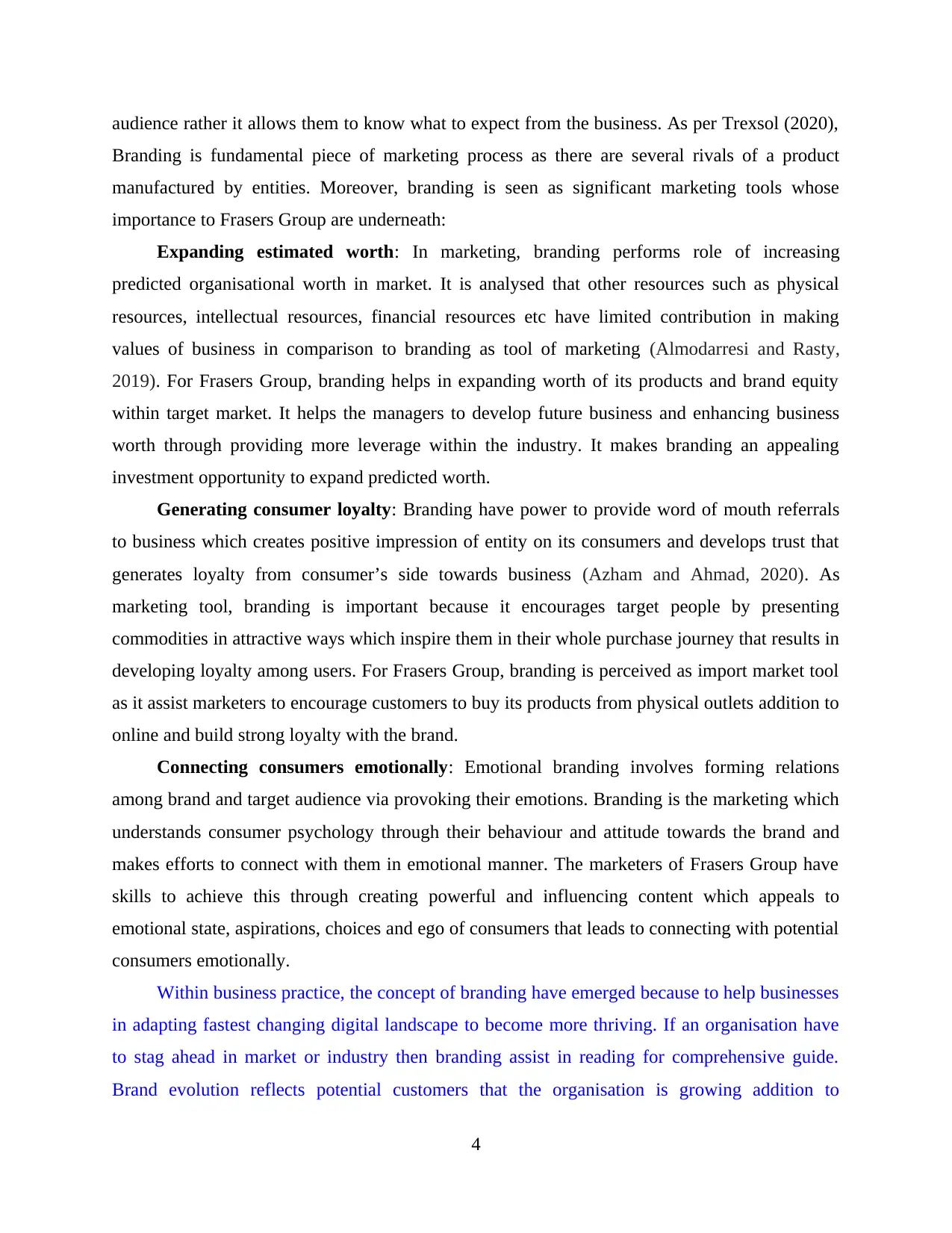
audience rather it allows them to know what to expect from the business. As per Trexsol (2020),
Branding is fundamental piece of marketing process as there are several rivals of a product
manufactured by entities. Moreover, branding is seen as significant marketing tools whose
importance to Frasers Group are underneath:
Expanding estimated worth: In marketing, branding performs role of increasing
predicted organisational worth in market. It is analysed that other resources such as physical
resources, intellectual resources, financial resources etc have limited contribution in making
values of business in comparison to branding as tool of marketing (Almodarresi and Rasty,
2019). For Frasers Group, branding helps in expanding worth of its products and brand equity
within target market. It helps the managers to develop future business and enhancing business
worth through providing more leverage within the industry. It makes branding an appealing
investment opportunity to expand predicted worth.
Generating consumer loyalty: Branding have power to provide word of mouth referrals
to business which creates positive impression of entity on its consumers and develops trust that
generates loyalty from consumer’s side towards business (Azham and Ahmad, 2020). As
marketing tool, branding is important because it encourages target people by presenting
commodities in attractive ways which inspire them in their whole purchase journey that results in
developing loyalty among users. For Frasers Group, branding is perceived as import market tool
as it assist marketers to encourage customers to buy its products from physical outlets addition to
online and build strong loyalty with the brand.
Connecting consumers emotionally: Emotional branding involves forming relations
among brand and target audience via provoking their emotions. Branding is the marketing which
understands consumer psychology through their behaviour and attitude towards the brand and
makes efforts to connect with them in emotional manner. The marketers of Frasers Group have
skills to achieve this through creating powerful and influencing content which appeals to
emotional state, aspirations, choices and ego of consumers that leads to connecting with potential
consumers emotionally.
Within business practice, the concept of branding have emerged because to help businesses
in adapting fastest changing digital landscape to become more thriving. If an organisation have
to stag ahead in market or industry then branding assist in reading for comprehensive guide.
Brand evolution reflects potential customers that the organisation is growing addition to
4
Branding is fundamental piece of marketing process as there are several rivals of a product
manufactured by entities. Moreover, branding is seen as significant marketing tools whose
importance to Frasers Group are underneath:
Expanding estimated worth: In marketing, branding performs role of increasing
predicted organisational worth in market. It is analysed that other resources such as physical
resources, intellectual resources, financial resources etc have limited contribution in making
values of business in comparison to branding as tool of marketing (Almodarresi and Rasty,
2019). For Frasers Group, branding helps in expanding worth of its products and brand equity
within target market. It helps the managers to develop future business and enhancing business
worth through providing more leverage within the industry. It makes branding an appealing
investment opportunity to expand predicted worth.
Generating consumer loyalty: Branding have power to provide word of mouth referrals
to business which creates positive impression of entity on its consumers and develops trust that
generates loyalty from consumer’s side towards business (Azham and Ahmad, 2020). As
marketing tool, branding is important because it encourages target people by presenting
commodities in attractive ways which inspire them in their whole purchase journey that results in
developing loyalty among users. For Frasers Group, branding is perceived as import market tool
as it assist marketers to encourage customers to buy its products from physical outlets addition to
online and build strong loyalty with the brand.
Connecting consumers emotionally: Emotional branding involves forming relations
among brand and target audience via provoking their emotions. Branding is the marketing which
understands consumer psychology through their behaviour and attitude towards the brand and
makes efforts to connect with them in emotional manner. The marketers of Frasers Group have
skills to achieve this through creating powerful and influencing content which appeals to
emotional state, aspirations, choices and ego of consumers that leads to connecting with potential
consumers emotionally.
Within business practice, the concept of branding have emerged because to help businesses
in adapting fastest changing digital landscape to become more thriving. If an organisation have
to stag ahead in market or industry then branding assist in reading for comprehensive guide.
Brand evolution reflects potential customers that the organisation is growing addition to
4
Paraphrase This Document
Need a fresh take? Get an instant paraphrase of this document with our AI Paraphraser
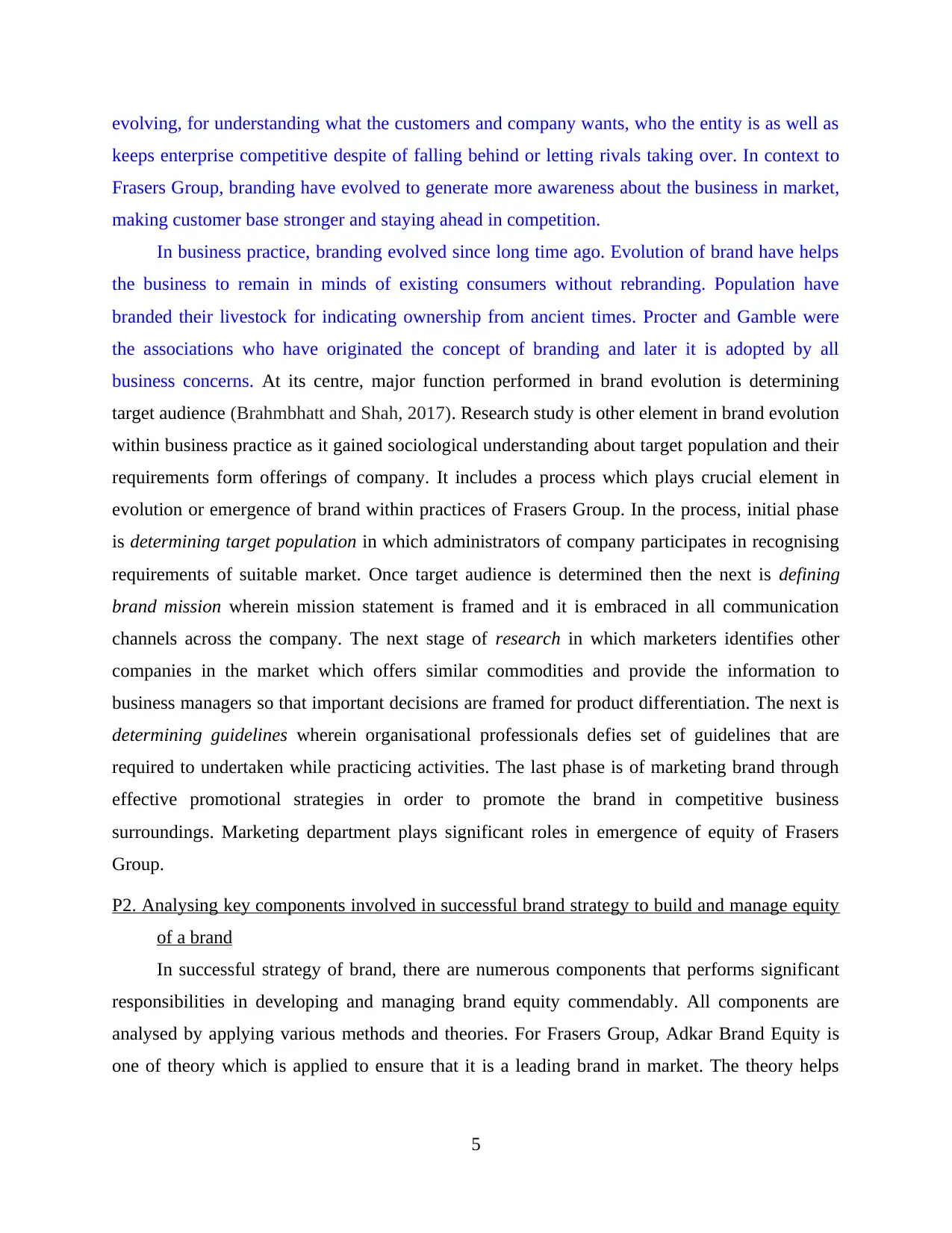
evolving, for understanding what the customers and company wants, who the entity is as well as
keeps enterprise competitive despite of falling behind or letting rivals taking over. In context to
Frasers Group, branding have evolved to generate more awareness about the business in market,
making customer base stronger and staying ahead in competition.
In business practice, branding evolved since long time ago. Evolution of brand have helps
the business to remain in minds of existing consumers without rebranding. Population have
branded their livestock for indicating ownership from ancient times. Procter and Gamble were
the associations who have originated the concept of branding and later it is adopted by all
business concerns. At its centre, major function performed in brand evolution is determining
target audience (Brahmbhatt and Shah, 2017). Research study is other element in brand evolution
within business practice as it gained sociological understanding about target population and their
requirements form offerings of company. It includes a process which plays crucial element in
evolution or emergence of brand within practices of Frasers Group. In the process, initial phase
is determining target population in which administrators of company participates in recognising
requirements of suitable market. Once target audience is determined then the next is defining
brand mission wherein mission statement is framed and it is embraced in all communication
channels across the company. The next stage of research in which marketers identifies other
companies in the market which offers similar commodities and provide the information to
business managers so that important decisions are framed for product differentiation. The next is
determining guidelines wherein organisational professionals defies set of guidelines that are
required to undertaken while practicing activities. The last phase is of marketing brand through
effective promotional strategies in order to promote the brand in competitive business
surroundings. Marketing department plays significant roles in emergence of equity of Frasers
Group.
P2. Analysing key components involved in successful brand strategy to build and manage equity
of a brand
In successful strategy of brand, there are numerous components that performs significant
responsibilities in developing and managing brand equity commendably. All components are
analysed by applying various methods and theories. For Frasers Group, Adkar Brand Equity is
one of theory which is applied to ensure that it is a leading brand in market. The theory helps
5
keeps enterprise competitive despite of falling behind or letting rivals taking over. In context to
Frasers Group, branding have evolved to generate more awareness about the business in market,
making customer base stronger and staying ahead in competition.
In business practice, branding evolved since long time ago. Evolution of brand have helps
the business to remain in minds of existing consumers without rebranding. Population have
branded their livestock for indicating ownership from ancient times. Procter and Gamble were
the associations who have originated the concept of branding and later it is adopted by all
business concerns. At its centre, major function performed in brand evolution is determining
target audience (Brahmbhatt and Shah, 2017). Research study is other element in brand evolution
within business practice as it gained sociological understanding about target population and their
requirements form offerings of company. It includes a process which plays crucial element in
evolution or emergence of brand within practices of Frasers Group. In the process, initial phase
is determining target population in which administrators of company participates in recognising
requirements of suitable market. Once target audience is determined then the next is defining
brand mission wherein mission statement is framed and it is embraced in all communication
channels across the company. The next stage of research in which marketers identifies other
companies in the market which offers similar commodities and provide the information to
business managers so that important decisions are framed for product differentiation. The next is
determining guidelines wherein organisational professionals defies set of guidelines that are
required to undertaken while practicing activities. The last phase is of marketing brand through
effective promotional strategies in order to promote the brand in competitive business
surroundings. Marketing department plays significant roles in emergence of equity of Frasers
Group.
P2. Analysing key components involved in successful brand strategy to build and manage equity
of a brand
In successful strategy of brand, there are numerous components that performs significant
responsibilities in developing and managing brand equity commendably. All components are
analysed by applying various methods and theories. For Frasers Group, Adkar Brand Equity is
one of theory which is applied to ensure that it is a leading brand in market. The theory helps
5
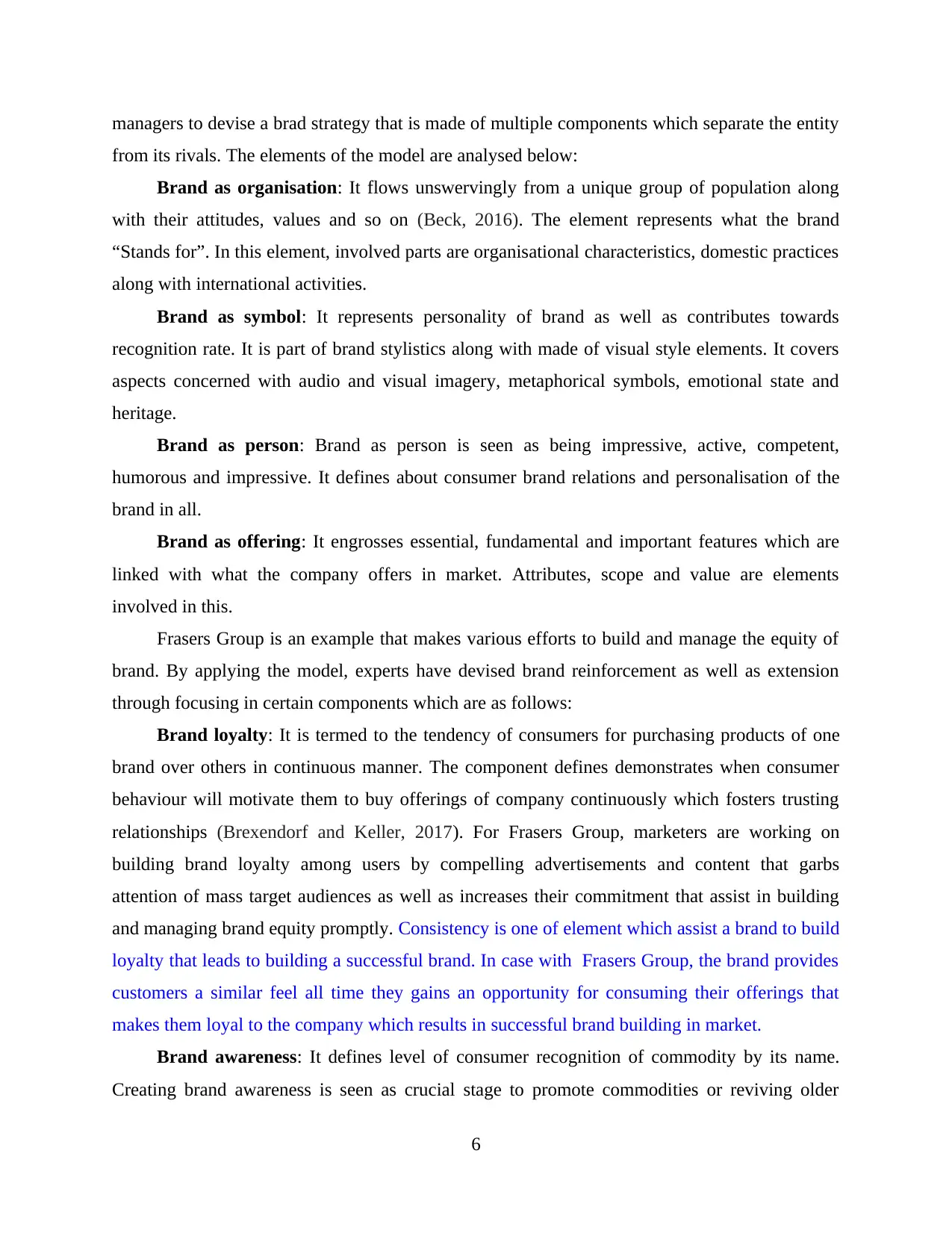
managers to devise a brad strategy that is made of multiple components which separate the entity
from its rivals. The elements of the model are analysed below:
Brand as organisation: It flows unswervingly from a unique group of population along
with their attitudes, values and so on (Beck, 2016). The element represents what the brand
“Stands for”. In this element, involved parts are organisational characteristics, domestic practices
along with international activities.
Brand as symbol: It represents personality of brand as well as contributes towards
recognition rate. It is part of brand stylistics along with made of visual style elements. It covers
aspects concerned with audio and visual imagery, metaphorical symbols, emotional state and
heritage.
Brand as person: Brand as person is seen as being impressive, active, competent,
humorous and impressive. It defines about consumer brand relations and personalisation of the
brand in all.
Brand as offering: It engrosses essential, fundamental and important features which are
linked with what the company offers in market. Attributes, scope and value are elements
involved in this.
Frasers Group is an example that makes various efforts to build and manage the equity of
brand. By applying the model, experts have devised brand reinforcement as well as extension
through focusing in certain components which are as follows:
Brand loyalty: It is termed to the tendency of consumers for purchasing products of one
brand over others in continuous manner. The component defines demonstrates when consumer
behaviour will motivate them to buy offerings of company continuously which fosters trusting
relationships (Brexendorf and Keller, 2017). For Frasers Group, marketers are working on
building brand loyalty among users by compelling advertisements and content that garbs
attention of mass target audiences as well as increases their commitment that assist in building
and managing brand equity promptly. Consistency is one of element which assist a brand to build
loyalty that leads to building a successful brand. In case with Frasers Group, the brand provides
customers a similar feel all time they gains an opportunity for consuming their offerings that
makes them loyal to the company which results in successful brand building in market.
Brand awareness: It defines level of consumer recognition of commodity by its name.
Creating brand awareness is seen as crucial stage to promote commodities or reviving older
6
from its rivals. The elements of the model are analysed below:
Brand as organisation: It flows unswervingly from a unique group of population along
with their attitudes, values and so on (Beck, 2016). The element represents what the brand
“Stands for”. In this element, involved parts are organisational characteristics, domestic practices
along with international activities.
Brand as symbol: It represents personality of brand as well as contributes towards
recognition rate. It is part of brand stylistics along with made of visual style elements. It covers
aspects concerned with audio and visual imagery, metaphorical symbols, emotional state and
heritage.
Brand as person: Brand as person is seen as being impressive, active, competent,
humorous and impressive. It defines about consumer brand relations and personalisation of the
brand in all.
Brand as offering: It engrosses essential, fundamental and important features which are
linked with what the company offers in market. Attributes, scope and value are elements
involved in this.
Frasers Group is an example that makes various efforts to build and manage the equity of
brand. By applying the model, experts have devised brand reinforcement as well as extension
through focusing in certain components which are as follows:
Brand loyalty: It is termed to the tendency of consumers for purchasing products of one
brand over others in continuous manner. The component defines demonstrates when consumer
behaviour will motivate them to buy offerings of company continuously which fosters trusting
relationships (Brexendorf and Keller, 2017). For Frasers Group, marketers are working on
building brand loyalty among users by compelling advertisements and content that garbs
attention of mass target audiences as well as increases their commitment that assist in building
and managing brand equity promptly. Consistency is one of element which assist a brand to build
loyalty that leads to building a successful brand. In case with Frasers Group, the brand provides
customers a similar feel all time they gains an opportunity for consuming their offerings that
makes them loyal to the company which results in successful brand building in market.
Brand awareness: It defines level of consumer recognition of commodity by its name.
Creating brand awareness is seen as crucial stage to promote commodities or reviving older
6
⊘ This is a preview!⊘
Do you want full access?
Subscribe today to unlock all pages.

Trusted by 1+ million students worldwide

brand. For Frasers Group, it is important component to develop and manage brand equity in
market. Ideally, brand awareness comprises characteristics which differentiates a business from
rivals. The marketing team of the establishment boost consciousness and attentiveness within
target groups through multiple channels including search engine optimisation, intermediates,
social media, etc to recall its identity that helps successfully in managing equity of brand. Brand
awareness contribute in building successful brand as it helps paving the way to attain variety of
business marketing goals as well as objectives such as staying ahead in rivalry, generating more
leads along with building an audience.
Brand association: It is concerned with duration when traits of brand are rooted in minds
of customers. Major objective of brand association is linkage of brand with positive attributes.
For Frasers Group, marketers are responsible to increase brand association through having
integration or communication with wider audiences and sharing information related to necessary
benefits from purchasing organisation offerings. With this, success is achieved timely and equity
of brand is managed resourcefully. Within Frasers Group, brand associations is the element that
generates value as well as equity of company linked with positive variables that legitimately
build the company as successful brand.
It is important for all organisations to build and execute essential concepts and model to
improvise brand and deal with negative crisis (Cheung and Baum, 2018). In relevance to Frasers
Group, professionals can apply focused concept. Moreover, it is analysed that the organisation
have faced certain challenges in last couple of years that includes battle over re-election,
minimum wage claims and profit warning amid disruption due to coronavirus that directly
influence brand equity in overseas market. At same time, the company have also faced issue of
neglecting legislations because of which its distribution system is greatly hampered. To deal with
such situation, Frasers Group managers can install Automation Technology and Customer
Relationship Management systems so that all its distribution system is managed without human
errors and relations with customers are managed properly.
M1. Evaluating the ways brands are managed in successful aspects over time by using
application of suitable models and theories
All business concerns executes suitable models to manage its activities successfully. In
context to Frasers Group, managers have manages all practices of the brand by applying Adkar
Brand Equity model in order to improve all related concerns of the brand. In this, main
7
market. Ideally, brand awareness comprises characteristics which differentiates a business from
rivals. The marketing team of the establishment boost consciousness and attentiveness within
target groups through multiple channels including search engine optimisation, intermediates,
social media, etc to recall its identity that helps successfully in managing equity of brand. Brand
awareness contribute in building successful brand as it helps paving the way to attain variety of
business marketing goals as well as objectives such as staying ahead in rivalry, generating more
leads along with building an audience.
Brand association: It is concerned with duration when traits of brand are rooted in minds
of customers. Major objective of brand association is linkage of brand with positive attributes.
For Frasers Group, marketers are responsible to increase brand association through having
integration or communication with wider audiences and sharing information related to necessary
benefits from purchasing organisation offerings. With this, success is achieved timely and equity
of brand is managed resourcefully. Within Frasers Group, brand associations is the element that
generates value as well as equity of company linked with positive variables that legitimately
build the company as successful brand.
It is important for all organisations to build and execute essential concepts and model to
improvise brand and deal with negative crisis (Cheung and Baum, 2018). In relevance to Frasers
Group, professionals can apply focused concept. Moreover, it is analysed that the organisation
have faced certain challenges in last couple of years that includes battle over re-election,
minimum wage claims and profit warning amid disruption due to coronavirus that directly
influence brand equity in overseas market. At same time, the company have also faced issue of
neglecting legislations because of which its distribution system is greatly hampered. To deal with
such situation, Frasers Group managers can install Automation Technology and Customer
Relationship Management systems so that all its distribution system is managed without human
errors and relations with customers are managed properly.
M1. Evaluating the ways brands are managed in successful aspects over time by using
application of suitable models and theories
All business concerns executes suitable models to manage its activities successfully. In
context to Frasers Group, managers have manages all practices of the brand by applying Adkar
Brand Equity model in order to improve all related concerns of the brand. In this, main
7
Paraphrase This Document
Need a fresh take? Get an instant paraphrase of this document with our AI Paraphraser
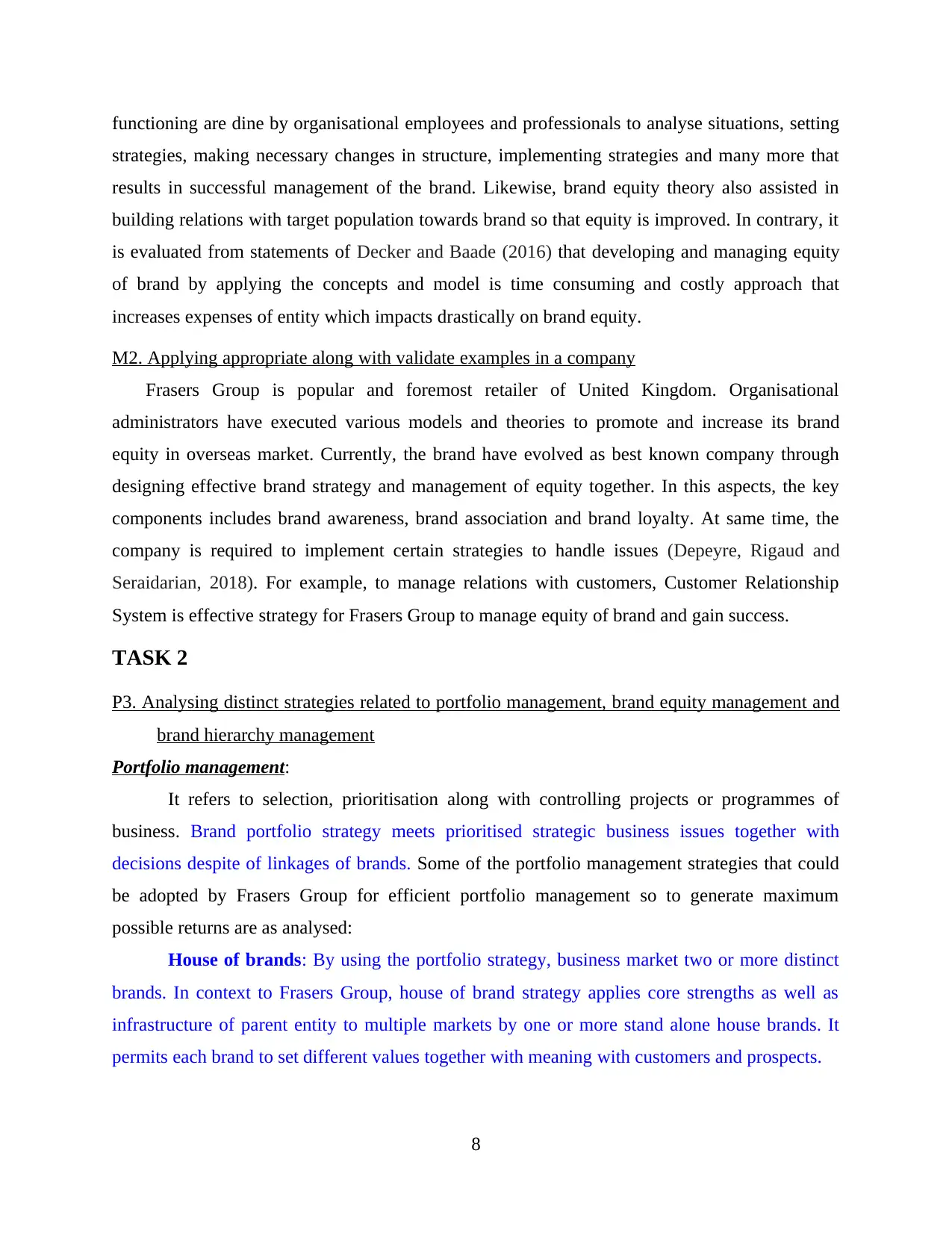
functioning are dine by organisational employees and professionals to analyse situations, setting
strategies, making necessary changes in structure, implementing strategies and many more that
results in successful management of the brand. Likewise, brand equity theory also assisted in
building relations with target population towards brand so that equity is improved. In contrary, it
is evaluated from statements of Decker and Baade (2016) that developing and managing equity
of brand by applying the concepts and model is time consuming and costly approach that
increases expenses of entity which impacts drastically on brand equity.
M2. Applying appropriate along with validate examples in a company
Frasers Group is popular and foremost retailer of United Kingdom. Organisational
administrators have executed various models and theories to promote and increase its brand
equity in overseas market. Currently, the brand have evolved as best known company through
designing effective brand strategy and management of equity together. In this aspects, the key
components includes brand awareness, brand association and brand loyalty. At same time, the
company is required to implement certain strategies to handle issues (Depeyre, Rigaud and
Seraidarian, 2018). For example, to manage relations with customers, Customer Relationship
System is effective strategy for Frasers Group to manage equity of brand and gain success.
TASK 2
P3. Analysing distinct strategies related to portfolio management, brand equity management and
brand hierarchy management
Portfolio management:
It refers to selection, prioritisation along with controlling projects or programmes of
business. Brand portfolio strategy meets prioritised strategic business issues together with
decisions despite of linkages of brands. Some of the portfolio management strategies that could
be adopted by Frasers Group for efficient portfolio management so to generate maximum
possible returns are as analysed:
House of brands: By using the portfolio strategy, business market two or more distinct
brands. In context to Frasers Group, house of brand strategy applies core strengths as well as
infrastructure of parent entity to multiple markets by one or more stand alone house brands. It
permits each brand to set different values together with meaning with customers and prospects.
8
strategies, making necessary changes in structure, implementing strategies and many more that
results in successful management of the brand. Likewise, brand equity theory also assisted in
building relations with target population towards brand so that equity is improved. In contrary, it
is evaluated from statements of Decker and Baade (2016) that developing and managing equity
of brand by applying the concepts and model is time consuming and costly approach that
increases expenses of entity which impacts drastically on brand equity.
M2. Applying appropriate along with validate examples in a company
Frasers Group is popular and foremost retailer of United Kingdom. Organisational
administrators have executed various models and theories to promote and increase its brand
equity in overseas market. Currently, the brand have evolved as best known company through
designing effective brand strategy and management of equity together. In this aspects, the key
components includes brand awareness, brand association and brand loyalty. At same time, the
company is required to implement certain strategies to handle issues (Depeyre, Rigaud and
Seraidarian, 2018). For example, to manage relations with customers, Customer Relationship
System is effective strategy for Frasers Group to manage equity of brand and gain success.
TASK 2
P3. Analysing distinct strategies related to portfolio management, brand equity management and
brand hierarchy management
Portfolio management:
It refers to selection, prioritisation along with controlling projects or programmes of
business. Brand portfolio strategy meets prioritised strategic business issues together with
decisions despite of linkages of brands. Some of the portfolio management strategies that could
be adopted by Frasers Group for efficient portfolio management so to generate maximum
possible returns are as analysed:
House of brands: By using the portfolio strategy, business market two or more distinct
brands. In context to Frasers Group, house of brand strategy applies core strengths as well as
infrastructure of parent entity to multiple markets by one or more stand alone house brands. It
permits each brand to set different values together with meaning with customers and prospects.
8
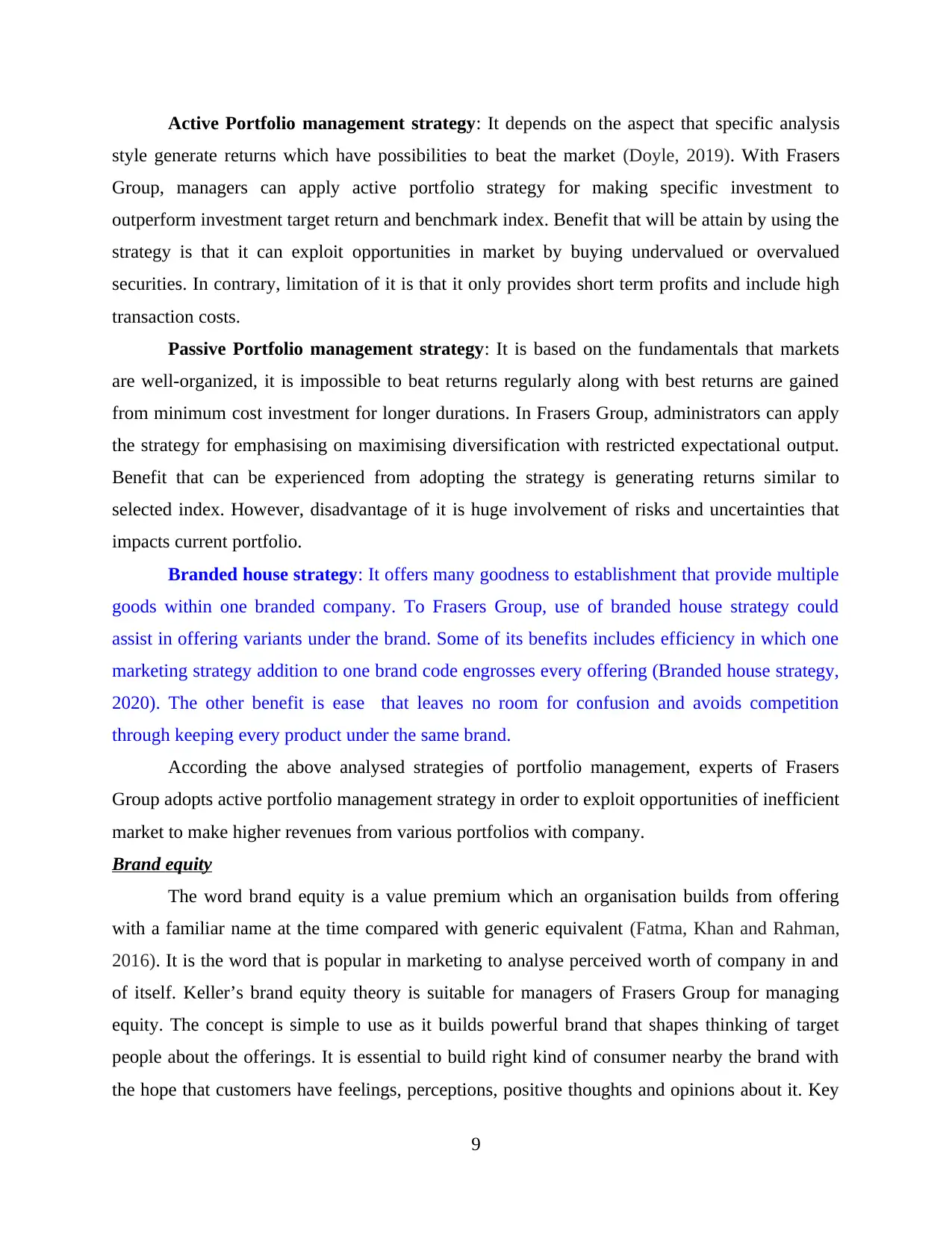
Active Portfolio management strategy: It depends on the aspect that specific analysis
style generate returns which have possibilities to beat the market (Doyle, 2019). With Frasers
Group, managers can apply active portfolio strategy for making specific investment to
outperform investment target return and benchmark index. Benefit that will be attain by using the
strategy is that it can exploit opportunities in market by buying undervalued or overvalued
securities. In contrary, limitation of it is that it only provides short term profits and include high
transaction costs.
Passive Portfolio management strategy: It is based on the fundamentals that markets
are well-organized, it is impossible to beat returns regularly along with best returns are gained
from minimum cost investment for longer durations. In Frasers Group, administrators can apply
the strategy for emphasising on maximising diversification with restricted expectational output.
Benefit that can be experienced from adopting the strategy is generating returns similar to
selected index. However, disadvantage of it is huge involvement of risks and uncertainties that
impacts current portfolio.
Branded house strategy: It offers many goodness to establishment that provide multiple
goods within one branded company. To Frasers Group, use of branded house strategy could
assist in offering variants under the brand. Some of its benefits includes efficiency in which one
marketing strategy addition to one brand code engrosses every offering (Branded house strategy,
2020). The other benefit is ease that leaves no room for confusion and avoids competition
through keeping every product under the same brand.
According the above analysed strategies of portfolio management, experts of Frasers
Group adopts active portfolio management strategy in order to exploit opportunities of inefficient
market to make higher revenues from various portfolios with company.
Brand equity
The word brand equity is a value premium which an organisation builds from offering
with a familiar name at the time compared with generic equivalent (Fatma, Khan and Rahman,
2016). It is the word that is popular in marketing to analyse perceived worth of company in and
of itself. Keller’s brand equity theory is suitable for managers of Frasers Group for managing
equity. The concept is simple to use as it builds powerful brand that shapes thinking of target
people about the offerings. It is essential to build right kind of consumer nearby the brand with
the hope that customers have feelings, perceptions, positive thoughts and opinions about it. Key
9
style generate returns which have possibilities to beat the market (Doyle, 2019). With Frasers
Group, managers can apply active portfolio strategy for making specific investment to
outperform investment target return and benchmark index. Benefit that will be attain by using the
strategy is that it can exploit opportunities in market by buying undervalued or overvalued
securities. In contrary, limitation of it is that it only provides short term profits and include high
transaction costs.
Passive Portfolio management strategy: It is based on the fundamentals that markets
are well-organized, it is impossible to beat returns regularly along with best returns are gained
from minimum cost investment for longer durations. In Frasers Group, administrators can apply
the strategy for emphasising on maximising diversification with restricted expectational output.
Benefit that can be experienced from adopting the strategy is generating returns similar to
selected index. However, disadvantage of it is huge involvement of risks and uncertainties that
impacts current portfolio.
Branded house strategy: It offers many goodness to establishment that provide multiple
goods within one branded company. To Frasers Group, use of branded house strategy could
assist in offering variants under the brand. Some of its benefits includes efficiency in which one
marketing strategy addition to one brand code engrosses every offering (Branded house strategy,
2020). The other benefit is ease that leaves no room for confusion and avoids competition
through keeping every product under the same brand.
According the above analysed strategies of portfolio management, experts of Frasers
Group adopts active portfolio management strategy in order to exploit opportunities of inefficient
market to make higher revenues from various portfolios with company.
Brand equity
The word brand equity is a value premium which an organisation builds from offering
with a familiar name at the time compared with generic equivalent (Fatma, Khan and Rahman,
2016). It is the word that is popular in marketing to analyse perceived worth of company in and
of itself. Keller’s brand equity theory is suitable for managers of Frasers Group for managing
equity. The concept is simple to use as it builds powerful brand that shapes thinking of target
people about the offerings. It is essential to build right kind of consumer nearby the brand with
the hope that customers have feelings, perceptions, positive thoughts and opinions about it. Key
9
⊘ This is a preview!⊘
Do you want full access?
Subscribe today to unlock all pages.

Trusted by 1+ million students worldwide
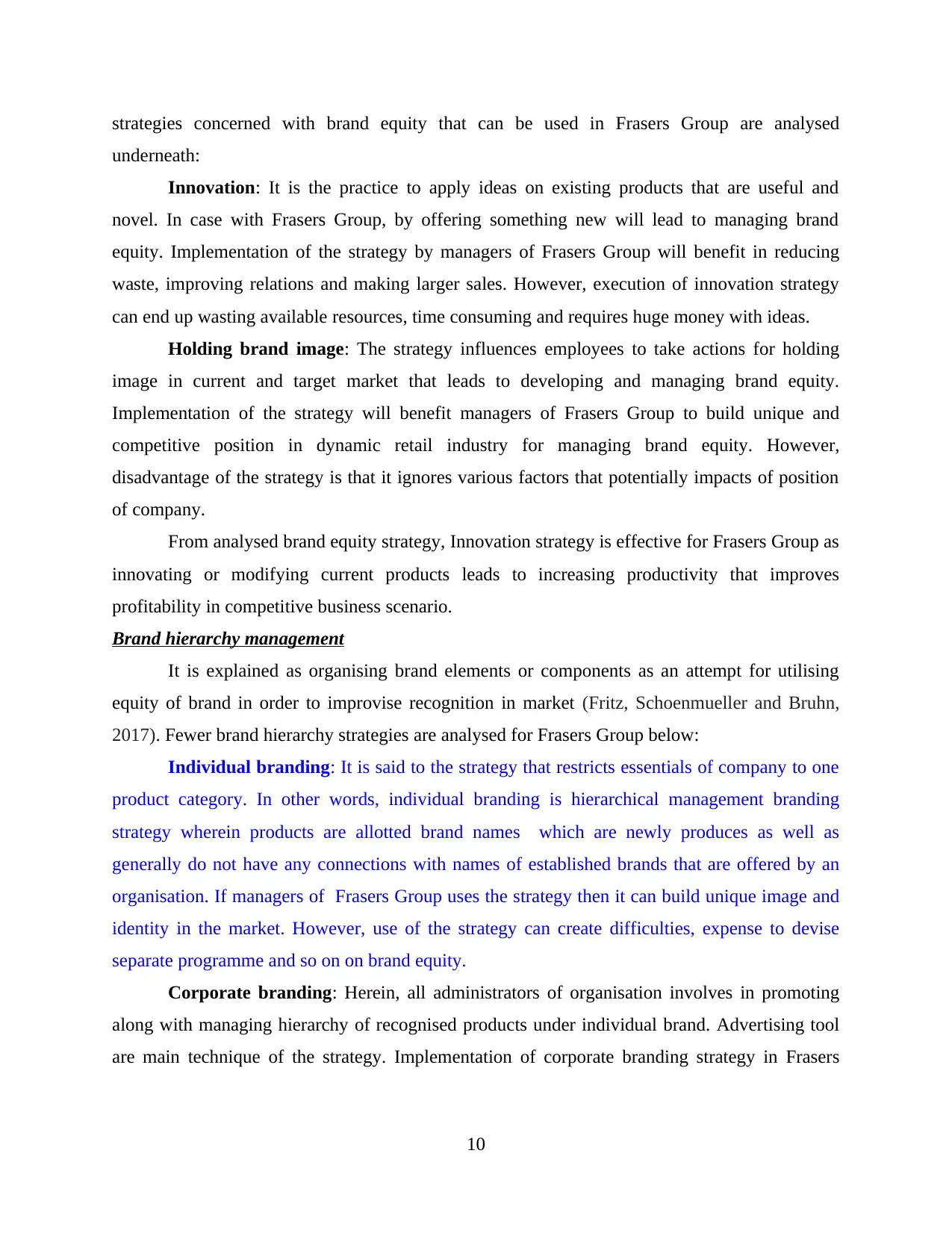
strategies concerned with brand equity that can be used in Frasers Group are analysed
underneath:
Innovation: It is the practice to apply ideas on existing products that are useful and
novel. In case with Frasers Group, by offering something new will lead to managing brand
equity. Implementation of the strategy by managers of Frasers Group will benefit in reducing
waste, improving relations and making larger sales. However, execution of innovation strategy
can end up wasting available resources, time consuming and requires huge money with ideas.
Holding brand image: The strategy influences employees to take actions for holding
image in current and target market that leads to developing and managing brand equity.
Implementation of the strategy will benefit managers of Frasers Group to build unique and
competitive position in dynamic retail industry for managing brand equity. However,
disadvantage of the strategy is that it ignores various factors that potentially impacts of position
of company.
From analysed brand equity strategy, Innovation strategy is effective for Frasers Group as
innovating or modifying current products leads to increasing productivity that improves
profitability in competitive business scenario.
Brand hierarchy management
It is explained as organising brand elements or components as an attempt for utilising
equity of brand in order to improvise recognition in market (Fritz, Schoenmueller and Bruhn,
2017). Fewer brand hierarchy strategies are analysed for Frasers Group below:
Individual branding: It is said to the strategy that restricts essentials of company to one
product category. In other words, individual branding is hierarchical management branding
strategy wherein products are allotted brand names which are newly produces as well as
generally do not have any connections with names of established brands that are offered by an
organisation. If managers of Frasers Group uses the strategy then it can build unique image and
identity in the market. However, use of the strategy can create difficulties, expense to devise
separate programme and so on on brand equity.
Corporate branding: Herein, all administrators of organisation involves in promoting
along with managing hierarchy of recognised products under individual brand. Advertising tool
are main technique of the strategy. Implementation of corporate branding strategy in Frasers
10
underneath:
Innovation: It is the practice to apply ideas on existing products that are useful and
novel. In case with Frasers Group, by offering something new will lead to managing brand
equity. Implementation of the strategy by managers of Frasers Group will benefit in reducing
waste, improving relations and making larger sales. However, execution of innovation strategy
can end up wasting available resources, time consuming and requires huge money with ideas.
Holding brand image: The strategy influences employees to take actions for holding
image in current and target market that leads to developing and managing brand equity.
Implementation of the strategy will benefit managers of Frasers Group to build unique and
competitive position in dynamic retail industry for managing brand equity. However,
disadvantage of the strategy is that it ignores various factors that potentially impacts of position
of company.
From analysed brand equity strategy, Innovation strategy is effective for Frasers Group as
innovating or modifying current products leads to increasing productivity that improves
profitability in competitive business scenario.
Brand hierarchy management
It is explained as organising brand elements or components as an attempt for utilising
equity of brand in order to improvise recognition in market (Fritz, Schoenmueller and Bruhn,
2017). Fewer brand hierarchy strategies are analysed for Frasers Group below:
Individual branding: It is said to the strategy that restricts essentials of company to one
product category. In other words, individual branding is hierarchical management branding
strategy wherein products are allotted brand names which are newly produces as well as
generally do not have any connections with names of established brands that are offered by an
organisation. If managers of Frasers Group uses the strategy then it can build unique image and
identity in the market. However, use of the strategy can create difficulties, expense to devise
separate programme and so on on brand equity.
Corporate branding: Herein, all administrators of organisation involves in promoting
along with managing hierarchy of recognised products under individual brand. Advertising tool
are main technique of the strategy. Implementation of corporate branding strategy in Frasers
10
Paraphrase This Document
Need a fresh take? Get an instant paraphrase of this document with our AI Paraphraser
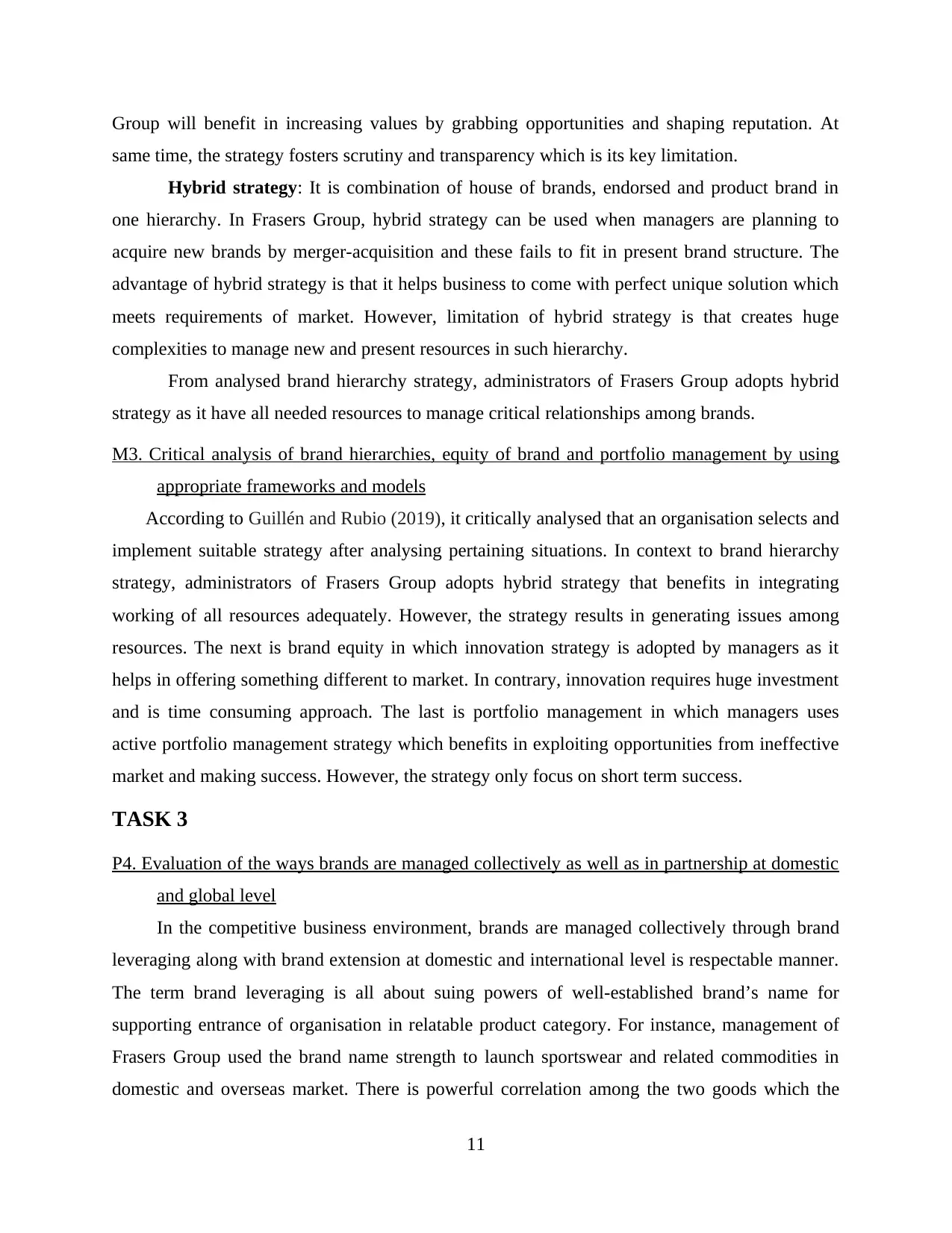
Group will benefit in increasing values by grabbing opportunities and shaping reputation. At
same time, the strategy fosters scrutiny and transparency which is its key limitation.
Hybrid strategy: It is combination of house of brands, endorsed and product brand in
one hierarchy. In Frasers Group, hybrid strategy can be used when managers are planning to
acquire new brands by merger-acquisition and these fails to fit in present brand structure. The
advantage of hybrid strategy is that it helps business to come with perfect unique solution which
meets requirements of market. However, limitation of hybrid strategy is that creates huge
complexities to manage new and present resources in such hierarchy.
From analysed brand hierarchy strategy, administrators of Frasers Group adopts hybrid
strategy as it have all needed resources to manage critical relationships among brands.
M3. Critical analysis of brand hierarchies, equity of brand and portfolio management by using
appropriate frameworks and models
According to Guillén and Rubio (2019), it critically analysed that an organisation selects and
implement suitable strategy after analysing pertaining situations. In context to brand hierarchy
strategy, administrators of Frasers Group adopts hybrid strategy that benefits in integrating
working of all resources adequately. However, the strategy results in generating issues among
resources. The next is brand equity in which innovation strategy is adopted by managers as it
helps in offering something different to market. In contrary, innovation requires huge investment
and is time consuming approach. The last is portfolio management in which managers uses
active portfolio management strategy which benefits in exploiting opportunities from ineffective
market and making success. However, the strategy only focus on short term success.
TASK 3
P4. Evaluation of the ways brands are managed collectively as well as in partnership at domestic
and global level
In the competitive business environment, brands are managed collectively through brand
leveraging along with brand extension at domestic and international level is respectable manner.
The term brand leveraging is all about suing powers of well-established brand’s name for
supporting entrance of organisation in relatable product category. For instance, management of
Frasers Group used the brand name strength to launch sportswear and related commodities in
domestic and overseas market. There is powerful correlation among the two goods which the
11
same time, the strategy fosters scrutiny and transparency which is its key limitation.
Hybrid strategy: It is combination of house of brands, endorsed and product brand in
one hierarchy. In Frasers Group, hybrid strategy can be used when managers are planning to
acquire new brands by merger-acquisition and these fails to fit in present brand structure. The
advantage of hybrid strategy is that it helps business to come with perfect unique solution which
meets requirements of market. However, limitation of hybrid strategy is that creates huge
complexities to manage new and present resources in such hierarchy.
From analysed brand hierarchy strategy, administrators of Frasers Group adopts hybrid
strategy as it have all needed resources to manage critical relationships among brands.
M3. Critical analysis of brand hierarchies, equity of brand and portfolio management by using
appropriate frameworks and models
According to Guillén and Rubio (2019), it critically analysed that an organisation selects and
implement suitable strategy after analysing pertaining situations. In context to brand hierarchy
strategy, administrators of Frasers Group adopts hybrid strategy that benefits in integrating
working of all resources adequately. However, the strategy results in generating issues among
resources. The next is brand equity in which innovation strategy is adopted by managers as it
helps in offering something different to market. In contrary, innovation requires huge investment
and is time consuming approach. The last is portfolio management in which managers uses
active portfolio management strategy which benefits in exploiting opportunities from ineffective
market and making success. However, the strategy only focus on short term success.
TASK 3
P4. Evaluation of the ways brands are managed collectively as well as in partnership at domestic
and global level
In the competitive business environment, brands are managed collectively through brand
leveraging along with brand extension at domestic and international level is respectable manner.
The term brand leveraging is all about suing powers of well-established brand’s name for
supporting entrance of organisation in relatable product category. For instance, management of
Frasers Group used the brand name strength to launch sportswear and related commodities in
domestic and overseas market. There is powerful correlation among the two goods which the
11
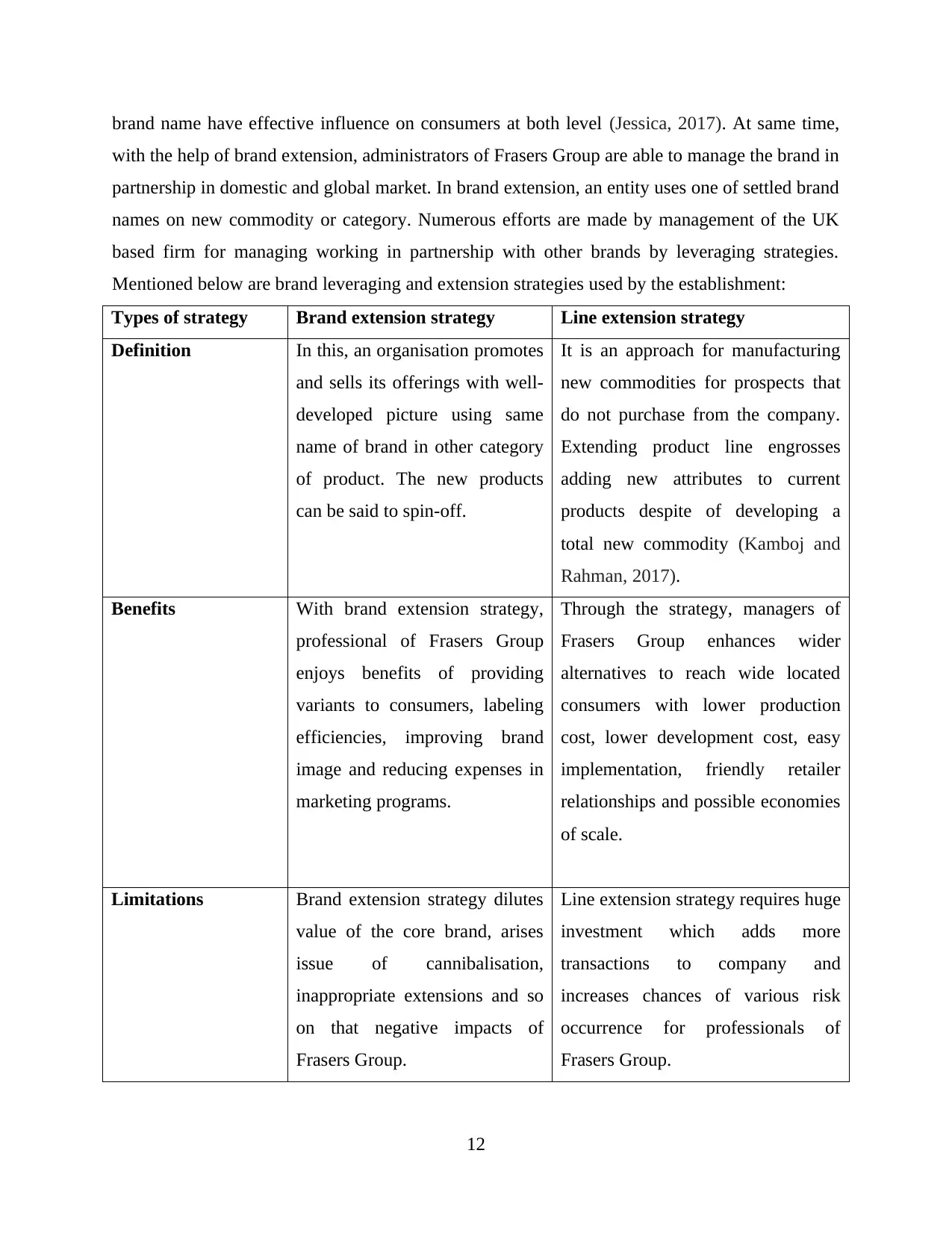
brand name have effective influence on consumers at both level (Jessica, 2017). At same time,
with the help of brand extension, administrators of Frasers Group are able to manage the brand in
partnership in domestic and global market. In brand extension, an entity uses one of settled brand
names on new commodity or category. Numerous efforts are made by management of the UK
based firm for managing working in partnership with other brands by leveraging strategies.
Mentioned below are brand leveraging and extension strategies used by the establishment:
Types of strategy Brand extension strategy Line extension strategy
Definition In this, an organisation promotes
and sells its offerings with well-
developed picture using same
name of brand in other category
of product. The new products
can be said to spin-off.
It is an approach for manufacturing
new commodities for prospects that
do not purchase from the company.
Extending product line engrosses
adding new attributes to current
products despite of developing a
total new commodity (Kamboj and
Rahman, 2017).
Benefits With brand extension strategy,
professional of Frasers Group
enjoys benefits of providing
variants to consumers, labeling
efficiencies, improving brand
image and reducing expenses in
marketing programs.
Through the strategy, managers of
Frasers Group enhances wider
alternatives to reach wide located
consumers with lower production
cost, lower development cost, easy
implementation, friendly retailer
relationships and possible economies
of scale.
Limitations Brand extension strategy dilutes
value of the core brand, arises
issue of cannibalisation,
inappropriate extensions and so
on that negative impacts of
Frasers Group.
Line extension strategy requires huge
investment which adds more
transactions to company and
increases chances of various risk
occurrence for professionals of
Frasers Group.
12
with the help of brand extension, administrators of Frasers Group are able to manage the brand in
partnership in domestic and global market. In brand extension, an entity uses one of settled brand
names on new commodity or category. Numerous efforts are made by management of the UK
based firm for managing working in partnership with other brands by leveraging strategies.
Mentioned below are brand leveraging and extension strategies used by the establishment:
Types of strategy Brand extension strategy Line extension strategy
Definition In this, an organisation promotes
and sells its offerings with well-
developed picture using same
name of brand in other category
of product. The new products
can be said to spin-off.
It is an approach for manufacturing
new commodities for prospects that
do not purchase from the company.
Extending product line engrosses
adding new attributes to current
products despite of developing a
total new commodity (Kamboj and
Rahman, 2017).
Benefits With brand extension strategy,
professional of Frasers Group
enjoys benefits of providing
variants to consumers, labeling
efficiencies, improving brand
image and reducing expenses in
marketing programs.
Through the strategy, managers of
Frasers Group enhances wider
alternatives to reach wide located
consumers with lower production
cost, lower development cost, easy
implementation, friendly retailer
relationships and possible economies
of scale.
Limitations Brand extension strategy dilutes
value of the core brand, arises
issue of cannibalisation,
inappropriate extensions and so
on that negative impacts of
Frasers Group.
Line extension strategy requires huge
investment which adds more
transactions to company and
increases chances of various risk
occurrence for professionals of
Frasers Group.
12
⊘ This is a preview!⊘
Do you want full access?
Subscribe today to unlock all pages.

Trusted by 1+ million students worldwide
1 out of 19
Related Documents
Your All-in-One AI-Powered Toolkit for Academic Success.
+13062052269
info@desklib.com
Available 24*7 on WhatsApp / Email
![[object Object]](/_next/static/media/star-bottom.7253800d.svg)
Unlock your academic potential
Copyright © 2020–2025 A2Z Services. All Rights Reserved. Developed and managed by ZUCOL.




